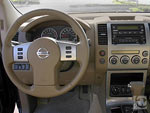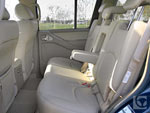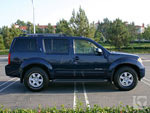 Nissan's classic sport-utility has led a long, colorful life. It was around to witness the birth of the Ford Explorer, made a name for itself before the segment took off, and somehow always found moderate success as a slightly left-field alternative. First it was the two-door freak with the sports car handling, then it was the marshmallow with unibody construction, then it was that muscle truck in that commercial with all those guys playing croquet to the rhythm of The Who's "Teenage Wasteland."
Nissan's classic sport-utility has led a long, colorful life. It was around to witness the birth of the Ford Explorer, made a name for itself before the segment took off, and somehow always found moderate success as a slightly left-field alternative. First it was the two-door freak with the sports car handling, then it was the marshmallow with unibody construction, then it was that muscle truck in that commercial with all those guys playing croquet to the rhythm of The Who's "Teenage Wasteland."But on the SUV timeline, those years stand worlds apart from 2005, the first year of this new Pathfinder. First, Nissan knowingly hatched it into a life of being boxed in by a crowded family, with the XTerra on the bottom, the Armada on top, and the Murano right in its face. Externally, the Pathfinder also faces new conflicting pressures like upping the power ante while drinking less of that $3 gas, becoming a legit off-roader while keeping its street-friendly demeanor, and throwing in extra seats into the same-size package, all amidst the possibility that the end may be near for this decreasingly fashionable mode of transportation.
Nissan's best solutions to these myriad problems join together in interesting ways to form the third-generation Pathfinder.
Road Test

First, note the change of camps. After spending a whole generation in its own unibody universe, the Pathfinder got absorbed into the "F-Alpha" family of traditional body-on-frame designs - the same mold that formed the XTerra, Armada, Frontier, and Titan. So unless you're the type to define a truck as "something you can use to sell fruit out of the back," let's all warmly welcome the Pathfinder back to truck-land.
On the other hand, get down on all fours and underneath the body you'll see the Pathfinder resting on its first-ever all-independent suspension - comprised of no less than a double-wishbone setup at each corner. Not only did that rescue the Pathfinder from its struts-and-live-axle ghetto, it elevated it to a plane higher than most cars will ever know.
The roadgoing attitude is a mix of the two. With the soft tires and soft suspension tuning, those four wheels smother irregularities with nearly the excellence and ease of a luxury car, despite the problematic freeway wind noise. The Pathfinder has also inherited the eager behavior of its chassis-mates, taking turns with most of the same poise that makes the Frontier and XTerra so endearing. The steering reacts naturally, feels set at the right speed (it's slower than the last Pathfinder's) and is quite adept at communication, all of which builds trust. Also, the balanced weight distribution (a perfect 50/50 on some models) explains why the front and back ends of this SUV skid to roughly equal degrees. The Pathfinder has that essential Nissan harmony.
It also has a lot of that deliberate sportiness Nissan has been forcefully packing into most of its cars. The 3.5-liter V6 that was once a big deal is now an even bigger deal at 4.0 liters thanks to a significant stroke extension (yet the bore remains bigger still). The Pathfinder's one of the few to not offer a V8, but with its 270 horsepower shaming the 240, 236, 215, 210, and 210 of the V6 Touareg, 4Runner, Montero, Explorer, and Grand Cherokee/Commander (trailing only the TrailBlazer), who needs one? The Pathfinder is about as fast as a last-generation Maxima, and going by that thundering engine racket under acceleration and a touchy gas pedal that's stuck in drag race mode, Nissan wants to drive the message home.
But the trucky ladder frame packed on more poundage than this SUV has ever seen. Weighed down with nearly 500 more than the last Pathfinder, the added inertia in every move is especially obvious in the dive-happy braking (compounded by a soft pedal) and tippy handling. Coupled with the power and the aforementioned friskiness in the chassis, driving adventurously makes the Pathfinder feel kind of like a quarterback trying to figure-skate. Abysmal tire grip will make you believe you're on ice, too. Yeah, it's safe to say most of the Pathfinder's sportiness is limited to straight lines.
It doesn't help that all this takes place 9.2 inches off the pavement in this SE Off-Road model, which also throws in Rancho off-road performance shocks, skid plates, and these compromised P265/75R16 BFGoodrich Rugged Trail tires. Of course, they were compromised for a reason - to tackle the wilderness - and despite the un-rugged independent suspension and lowered approach and departure angles, you could argue the Pathfinder's got more going for it than before. First, you've got your real 4-wheel-drive system with High range and 2.625 Low range. Second, there's Hill Start Assist to keep you from rolling back when starting uphill, and third is Hill Descent Control to let you roll down a hill slowly and safely. So the Pathfinder's legit.
The LE model goes one better by offering full-time all-wheel-drive for use on city streets, obviously the place where most Pathfinders will spend all of their lives. Fortunately, they've been well-prepared.
Inside & Out

The average 2.5-kid family has been demanding seats for seven in their mid-size SUVs lately. Nissan has complied, stretching the Pathfinder to 187.6 inches long (up 4.9 from the last and 15.7 from the first), 112.2 in wheelbase (up 5.9), and an inch or two wider and taller. This and the space saved by the independent rear suspension made that new bench possible. What's not possible is for two adults to sit there with any degree of comfort. With no more than 28.1 inches of legroom, all but the shortest adults will sit with knees jammed into the backs of the second-row passengers, which is the only source of leg support since the seat's down on the slightly elevated floor. Then there's the issue of the undignified climb over the second row to get there in the first place. Kids should find it perfectly fine, as long as they can jump up to reach those five-foot-high door handles.
With all that room, you'd think more could have been done with the second row, but the main back seat is still just OK. You can park feet under the front seats (barely), but a protruding section of your own eats up footroom from behind. Some of that generous headroom should be traded in for a higher, longer seat cushion, and why must Nissan truck armrests slope uphill? Things are fine otherwise: a nearly flat floor, great headroom, and good padding. Adjustable head restraints and good-fitting three-point seat belts adorn all seven positions.
Up in the front row, I find myself empty on complaints. With perfect room, contouring, and adjustments, these are true thrones. The leather covering every seat (in the first two rows) and dashboard item is as attractive as it is luxurious.
Nissans born between 2002-2004 seem to be victims of interior penny-pinching. Luckily, the Pathfinder is from the class of 2005 and shows no such symptoms. Knobs and compartments move satisfyingly, and I couldn't find one item that felt like it was prone to snap. Even the aluminum-wannabe plastic didn't look too out of whack.
Control design adds to the picture perfection aside from climate controls that look like rotary knobs but are just fussy toggle switches in disguise. I especially like the quick-acting MP3 stereo head unit, and fans of powerful audio will go ga-ga for the optional nine-speaker Bose upgrade, whose subwoofer sounds fierce enough to alert the neighborhood watch, even if notes don't come through especially warmly. Finally, electricity access is plentiful thanks to two power outlets on the dash, a third in the big console, and a fourth in the cargo hold.
Cargo would be a Pathfinder specialty. A 16.5 cubic foot capacity matches most mid-size sedans, 49.2 in five-seater mode nearly matches a small wagon, and 79.2 with all seats down is about even with a Ford Taurus wagon. But that last number falls short of the last Pathfinder's (suggesting that third seat wasn't free in every regard), and is a disgrace compared to the 148.7 cubes of Nissan's own Quest, whose superiority extends to both seating and ease of conversion between cargo-mover and people-mover mode. At least the Pathfinder's user-friendly back door (containing a handy first-aid kit) and independently-opening window ease access, and all seats are reasonably easy to fold and unfold.
Other Thoughts

The redesigned Pathfinder expanded to four trim lines: the XE, SE, SE Off-Road, and LE models, all in 2WD or 4WD. For 2006, Nissan realized that a 2WD Off-Road model was a walking contradiction and killed it. They also added one color: the Majestic Blue shade adorning our sparkling sample.
Even the $25,830 XE has core features like power everything, cruise control, keyless entry, alloy wheels, antilock brakes, and traction and stability control. The $1,250-higher SE ($27,080) adds a power seat, folding passenger's seat, roof rack, running boards, fog lights, body-color mirrors, front tow hook, Easy Clean cargo area, and first-aid kit. After the 4WD SE, the $2,800-higher SE Off-Road ($31,880) gets the Rancho off-road shocks, Hill Descent Control, Hill Start Assist, skid plates, exclusive alloy wheels and tires, dual-zone climate control, rear A/C controls, auto-dimming mirror, leather steering wheel and shifter, aluminum trim, and power adjustable pedals. And starting from the SE again, the $6,850-higher LE ($33,930) adds the SE Off-Road's luxury content (but not the hardware) plus 17-inch wheels, sunroof, Bose stereo, driver memory, heated leather seats, power passenger seat, wood interior trim, and side and side-curtain airbags. 4-wheel-drive runs $2,000 on the XE and SE, $2,200 on the LE. The Comfort, Premium, and Leather Packages can add much of these items to lesser models, while DVD, navigation, and side air bags remain the major options.
Many competitors have some kind of leg-up on the Pathfinder. Jeep and Volkswagen have advanced 4-wheel-drive systems and the unibody construction Nissan abandoned, the TrailBlazer has a little more power and a little less price, and available V8 engines in several SUVs satisfy people's heavy-duty needs, real or perceived.
But the Pathfinder's the only one with no serious flaws, like the TrailBlazer's back-killer seats and lousy interior or the borderline laughable acceleration of the Touareg, Montero, Explorer, and Jeeps. The Pathfinder's V6 tops the class for power, technology, and feel, it delivers the best on-road driving experience (partly thanks to the best on-road suspension), has probably the nicest interior, and its sticker price makes the 4Runner, Montero, and Touareg look like rip-offs. Another best-in-class entry from Nissan? Sure looks that way.
But while we're being rational, do you really need a trucky SUV like this? The answer is yes if you must: A. haul a 6,000-pound trailer and B. go off road. If all you need are a ton of seats and space, a Quest, Sienna, or Odyssey would work better for both tasks while getting better mileage than our pathetic 14 MPG. For the vanphobic, so would Ford's Freestyle.
And if you can get by with five chairs but are too gullible to be reasoned out of an SUV, check out Nissan's Murano. Even while matching the Pathfinder inch for inch (literally: 187.6 for both), the Murano's Altima-based chassis shaves off 700 pounds of vehicular obesity. It, too, holds more cargo and gives greater comfort to passengers 3, 4, and 5, holds the road more skillfully, and its 3.5-liter V6 is just as fast yet ekes out more mileage. If a more casual AWD system and 3,500 pounds of towing will do, this is a gain with few losses.
And to get really smart, there are wagons of similar size: Mazda 6, Subaru Legacy, Volkswagen's upcoming Passat. Each can run circles around the Pathfinder in performance, save about $5,000 at the outset (except the Passat), then save another $5,000 after about six years of refuels. Kind of like earning $10,000 to treat yourself to a better time, isn't it? [source : automotive.com]
Post a Comment